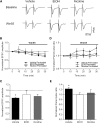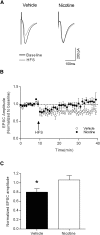Tolerance to Ethanol or Nicotine Results in Increased Ethanol Self-Administration and Long-Term Depression in the Dorsolateral Striatum
- PMID: 27517088
- PMCID: PMC4972936
- DOI: 10.1523/ENEURO.0112-15.2016
Tolerance to Ethanol or Nicotine Results in Increased Ethanol Self-Administration and Long-Term Depression in the Dorsolateral Striatum
Abstract
Ethanol (EtOH) and nicotine are the most widely coabused drugs. Tolerance to EtOH intoxication, including motor impairment, results in greater EtOH consumption and may result in a greater likelihood of addiction. Previous studies suggest that cross-tolerance between EtOH and nicotine may contribute to the abuse potential of these drugs. Here we demonstrate that repeated intermittent administration of either EtOH or nicotine in adult male Sprague Dawley rats results in tolerance to EtOH-induced motor impairment and increased EtOH self-administration. These findings suggest that nicotine and EtOH cross-tolerance results in decreased aversive and enhanced rewarding effects of EtOH. Endocannabinoid signaling in the dorsolateral striatum (DLS) has been implicated in both EtOH tolerance and reward, so we investigated whether nicotine or EtOH pretreatment might modulate endocannabinoid signaling in this region. Using similar EtOH and nicotine pretreatment methods resulted in increased paired-pulse ratios of evoked EPSCs in enkephalin-positive medium spiny neurons in DLS slices. Thus, EtOH and nicotine pretreatment may modulate glutamatergic synapses in the DLS presynaptically. Bath application of the CB1 receptor agonist Win 55,2-212 increased the paired-pulse ratio of evoked EPSCs in control slices, while Win 55,2-212 had no effect on paired-pulse ratio in slices from either EtOH- or nicotine-pretreated rats. Consistent with these effects, nicotine pretreatment occluded LTD induction by high-frequency stimulation of the corticostriatal inputs to the dorsolateral striatum. These results suggest that nicotine and EtOH pretreatment modulates striatal synapses to induce tolerance to the motor-impairing effects of EtOH, which may contribute to nicotine and EtOH coabuse.
Keywords: addiction; endocanabinoid; motor impairment; reward; self-administration.
Figures






References
-
- Basavarajappa BS, Cooper TB, Hungund BL (1998) Chronic ethanol administration down-regulates cannabinoid receptors in mouse brain synaptic plasma membrane. Brain Res 793:212–218. - PubMed
Publication types
MeSH terms
Substances
Grants and funding
LinkOut - more resources
Full Text Sources
Other Literature Sources
Medical
Miscellaneous
